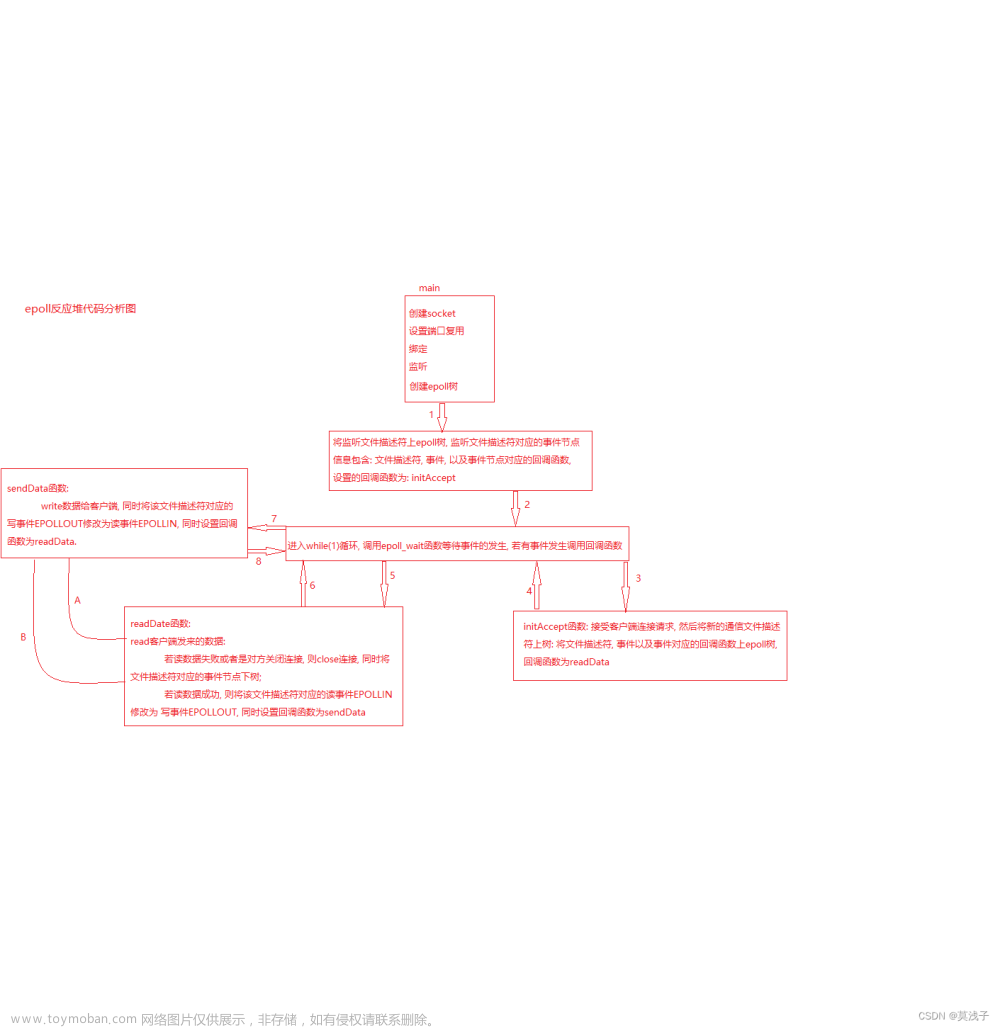目录
1 适用场景
2 POLL机制的内核代码详解
2.1 sys_poll 函数
2.2 do_sys_poll 函数
2.3 do_poll函数
3 poll机制使用流程
4 驱动编程
5 应用编程
6 代码
6.1 gpio_key_drv.c
6.2 button_test.c
6.3 Makefile
可以看 字符设备驱动程序之poll机制 那篇文章中的机制分析以及代码去理解POLL机制,看完那篇文章也就理解POLL机制了,下面的这篇文章也可以不看。
1 适用场景
在前面引入中断时,我们曾经举过一个例子:妈妈怎么知道卧室里小孩醒了?
poll 方式:妈妈要干很多活,但是可以陪小孩睡一会,定个闹钟,要浪费点时间,但是可以继续干活。妈妈要么是被小孩吵醒,要么是被闹钟吵醒。
使用休眠-唤醒的方式等待某个事件发生时,有一个缺点:等待的时间可能很久。我们可以加上一个超时时间,这时就可以使用 poll 机制。
- APP 不知道驱动程序中是否有数据,可以先调用 poll 函数查询一下,poll 函数可以传入超时时间;
- APP 进入内核态,调用到驱动程序的 poll 函数,如果有数据的话立刻返回;
- 如果发现没有数据时就休眠一段时间;
- 当有数据时,比如当按下按键时,驱动程序的中断服务程序被调用,它会记录数据、唤醒 APP;
- 当超时时间到了之后,内核也会唤醒 APP;
- APP 根据 poll 函数的返回值就可以知道是否有数据,如果有数据就调用read 得到数据。
2 POLL机制的内核代码详解
Linux APP 系统调用,基本都可以在它的名字前加上“sys_”前缀,这就是它在内核中对应的函数。比如系统调用 open、read、write、poll,与之对应的内核函数为:sys_open、sys_read、sys_write、sys_poll。
对于系统调用 poll 或 select,它们对应的内核函数都是 sys_poll。分析sys_poll,即可理解 poll 机制。
2.1 sys_poll 函数
sys_poll 位于 fs/select.c 文件中,代码如下:
SYSCALL_DEFINE3(poll, struct pollfd __user *, ufds, unsigned int, nfds,
int, timeout_msecs)
{
struct timespec64 end_time, *to = NULL;
int ret;
if (timeout_msecs >= 0) {
to = &end_time;
poll_select_set_timeout(to, timeout_msecs / MSEC_PER_SEC,
NSEC_PER_MSEC * (timeout_msecs % MSEC_PER_SEC));
}
ret = do_sys_poll(ufds, nfds, to);
…… SYSCALL_DEFINE3 是一个宏,它定义于 include/linux/syscalls.h,展开后就有 sys_poll 函数。
sys_poll 对超时参数稍作处理后,直接调用 do_sys_poll。
2.2 do_sys_poll 函数
do_sys_poll 位于 fs/select.c 文件中,我们忽略其他代码,只看关键部分:
int do_sys_poll(struct pollfd __user *ufds, unsigned int nfds,
struct timespec64 *end_time)
{
……
poll_initwait(&table);
fdcount = do_poll(head, &table, end_time);
poll_freewait(&table);
……
} poll_initwait 函数非常简单,它初始化一个 poll_wqueues 变量 table:
poll_initwait
init_poll_funcptr(&pwq->pt, __pollwait);
pt->qproc = qproc; 即 table->pt->qproc = __pollwait,__pollwait 将在驱动的 poll 函数里用到。do_poll 函数才是核心,继续看代码。
2.3 do_poll函数
do_poll 函数位于 fs/select.c 文件中,这是 POLL 机制中最核心的代码,贴图如下:

① 从这里开始,将会导致驱动程序的 poll 函数被第一次调用。 沿着②③④⑤,你可以看到:驱动程序里的 poll_wait 会调用__pollwait函数把线程放入某个队列。
当执行完①之后,在⑥或⑦处,pt->_qproc 被设置为 NULL,所以第二次调用驱动程序的 poll 时,不会再次把线程放入某个队列里。
⑧ 如果驱动程序的 poll 返回有效值,则 count 非 0,跳出循环;
⑨ 否则休眠一段时间;当休眠时间到,或是被中断唤醒时,会再次循环、再次调用驱动程序的 poll。
回顾 APP 的代码,APP 可以指定“想等待某些事件”,poll 函数返回后,可以知道“发生了哪些事件”:

驱动程序里怎么体现呢?在上上一个图中,看②位置处,细说如下: 
3 poll机制使用流程
妈妈进入房间时,会先看小孩醒没醒,闹钟响之后走出房间之前又会再看小孩醒没醒。注意:看了 2 次小孩! POLL 机制也是类似的,流程如下:

函数执行流程如上图①~⑧所示,重点从③开始看。假设一开始无按键数据:
③APP 调用 poll 之后,进入内核态;
④导致驱动程序的 drv_poll 被调用:
注意,drv_poll 要把自己这个线程挂入等待队列 wq 中;假设不放入队列里,那以后发生中断时,中断服务程序去哪里找到你嘛?
drv_poll 还会判断一下:有没有数据啊?返回这个状态。
⑤当前没有数据,则休眠一会;
⑥过程中,按下了按键,发生了中断: 在中断服务程序里记录了按键值,并且从 wq 中把线程唤醒了。
⑦从休眠中被唤醒,继续执行 for 循环,再次调用 drv_poll: drv_poll 返回数据状态
⑧哦,你有数据,那从内核态返回到应用态吧
⑨APP 调用 read 函数读数据
如果一直没有数据,调用流程也是类似的,重点从③开始看,如下:
③ APP 调用 poll 之后,进入内核态;
④ 导致驱动程序的 drv_poll 被调用:
注意,drv_poll 要把自己这个线程挂入等待队列 wq 中;假设不放入队列里,那以后发生中断时,中断服务程序去哪里找到你嘛?
drv_poll 还会判断一下:有没有数据啊?返回这个状态。
⑤ 假设当前没有数据,则休眠一会;
⑥ 在休眠过程中,一直没有按下了按键,超时时间到:内核把这个线程唤醒;
⑦ 线程从休眠中被唤醒,继续执行 for 循环,再次调用 drv_poll:drv_poll 返回数据状态
⑧ 哦,你还是没有数据,但是超时时间到了,那从内核态返回到应用态吧
⑨ APP 不能调用 read 函数读数据
注意几点:
- drv_poll 要把线程挂入队列 wq,但是并不是在 drv_poll 中进入休眠,而是在调用 drv_poll 之后休眠
- drv_poll 要返回数据状态
- APP 调用一次 poll,有可能会导致 drv_poll 被调用 2 次
- 线程被唤醒的原因有 2:中断发生了去队列 wq 中把它唤醒,超时时间到了内核把它唤醒
- APP 要判断 poll 返回的原因:有数据,还是超时。有数据时再去调用 read函数。
4 驱动编程
使用 poll 机制时,驱动程序的核心就是提供对应的 drv_poll 函数。在drv_poll 函数中要做 2 件事:
把当前线程挂入队列 wq:poll_wait
a) APP 调用一次 poll,可能导致 drv_poll 被调用 2 次,但是我们并不需要把当前线程挂入队列 2 次。
b) 可以使用内核的函数 poll_wait 把线程挂入队列,如果线程已经在队列里了,它就不会再次挂入。
返回设备状态:
APP 调用 poll 函数时,有可能是查询“有没有数据可以读”:POLLIN,也有可能是查询“你有没有空间给我写数据”:POLLOUT。所以 drv_poll 要返回自己的当前状态:(POLLIN | POLLRDNORM) 或 (POLLOUT | POLLWRNORM)。
a) POLLRDNORM 等同于 POLLIN,为了兼容某些 APP 把它们一起返回。
b) POLLWRNORM 等同于 POLLOUT ,为了兼容某些 APP 把它们一起返
回。
APP 调用 poll 后,很有可能会休眠。对应的,在按键驱动的中断服务程序中,也要有唤醒操作。
驱动程序中 poll 的代码如下:
static unsigned int gpio_key_drv_poll(struct file *fp, poll_table * wait)
{
printk("%s %s line %d\n", __FILE__, __FUNCTION__, __LINE__);
poll_wait(fp, &gpio_key_wait, wait);
return is_key_buf_empty() ? 0 : POLLIN | POLLRDNORM;
} 5 应用编程
注意:APP 可以调用 poll 或 select 函数,这 2 个函数的作用是一样的。 poll/select 函数可以监测多个文件,可以监测多种事件:  文章来源:https://www.toymoban.com/news/detail-752187.html
文章来源:https://www.toymoban.com/news/detail-752187.html
 在调用 poll 函数时,要指明:
在调用 poll 函数时,要指明:
⚫ 你要监测哪一个文件:哪一个 fd
⚫ 你想监测这个文件的哪种事件:是 POLLIN、还是 POLLOUT
最后,在 poll 函数返回时,要判断状态。
应用程序代码如下:文章来源地址https://www.toymoban.com/news/detail-752187.html
struct pollfd fds[1];
int timeout_ms = 5000;
int ret;
fds[0].fd = fd;
fds[0].events = POLLIN;
ret = poll(fds, 1, timeout_ms);
if ((ret == 1) && (fds[0].revents & POLLIN))
{
read(fd, &val, 4);
printf("get button : 0x%x\n", val);
} 6 代码
6.1 gpio_key_drv.c
#include <linux/module.h>
#include <linux/poll.h>
#include <linux/fs.h>
#include <linux/errno.h>
#include <linux/miscdevice.h>
#include <linux/kernel.h>
#include <linux/major.h>
#include <linux/mutex.h>
#include <linux/proc_fs.h>
#include <linux/seq_file.h>
#include <linux/stat.h>
#include <linux/init.h>
#include <linux/device.h>
#include <linux/tty.h>
#include <linux/kmod.h>
#include <linux/gfp.h>
#include <linux/gpio/consumer.h>
#include <linux/platform_device.h>
#include <linux/of_gpio.h>
#include <linux/of_irq.h>
#include <linux/interrupt.h>
#include <linux/irq.h>
#include <linux/slab.h>
struct gpio_key{
int gpio;
struct gpio_desc *gpiod;
int flag;
int irq;
} ;
static struct gpio_key *gpio_keys_100ask;
/* 主设备号 */
static int major = 0;
static struct class *gpio_key_class;
/* 环形缓冲区 */
#define BUF_LEN 128
static int g_keys[BUF_LEN];
static int r, w;
#define NEXT_POS(x) ((x+1) % BUF_LEN)
static int is_key_buf_empty(void)
{
return (r == w);
}
static int is_key_buf_full(void)
{
return (r == NEXT_POS(w));
}
static void put_key(int key)
{
if (!is_key_buf_full())
{
g_keys[w] = key;
w = NEXT_POS(w);
}
}
static int get_key(void)
{
int key = 0;
if (!is_key_buf_empty())
{
key = g_keys[r];
r = NEXT_POS(r);
}
return key;
}
static DECLARE_WAIT_QUEUE_HEAD(gpio_key_wait);
/* 实现对应的open/read/write等函数,填入file_operations结构体 */
static ssize_t gpio_key_drv_read (struct file *file, char __user *buf, size_t size, loff_t *offset)
{
//printk("%s %s line %d\n", __FILE__, __FUNCTION__, __LINE__);
int err;
int key;
wait_event_interruptible(gpio_key_wait, !is_key_buf_empty());
key = get_key();
err = copy_to_user(buf, &key, 4);
return 4;
}
static unsigned int gpio_key_drv_poll(struct file *fp, poll_table * wait)
{
printk("%s %s line %d\n", __FILE__, __FUNCTION__, __LINE__);
poll_wait(fp, &gpio_key_wait, wait);
return is_key_buf_empty() ? 0 : POLLIN | POLLRDNORM;
}
/* 定义自己的file_operations结构体 */
static struct file_operations gpio_key_drv = {
.owner = THIS_MODULE,
.read = gpio_key_drv_read,
.poll = gpio_key_drv_poll,
};
static irqreturn_t gpio_key_isr(int irq, void *dev_id)
{
struct gpio_key *gpio_key = dev_id;
int val;
int key;
val = gpiod_get_value(gpio_key->gpiod);
printk("key %d %d\n", gpio_key->gpio, val);
key = (gpio_key->gpio << 8) | val;
put_key(key);
wake_up_interruptible(&gpio_key_wait);
return IRQ_HANDLED;
}
/* 1. 从platform_device获得GPIO
* 2. gpio=>irq
* 3. request_irq
*/
static int gpio_key_probe(struct platform_device *pdev)
{
int err;
struct device_node *node = pdev->dev.of_node;
int count;
int i;
enum of_gpio_flags flag;
printk("%s %s line %d\n", __FILE__, __FUNCTION__, __LINE__);
count = of_gpio_count(node);
if (!count)
{
printk("%s %s line %d, there isn't any gpio available\n", __FILE__, __FUNCTION__, __LINE__);
return -1;
}
gpio_keys_100ask = kzalloc(sizeof(struct gpio_key) * count, GFP_KERNEL);
for (i = 0; i < count; i++)
{
gpio_keys_100ask[i].gpio = of_get_gpio_flags(node, i, &flag);
if (gpio_keys_100ask[i].gpio < 0)
{
printk("%s %s line %d, of_get_gpio_flags fail\n", __FILE__, __FUNCTION__, __LINE__);
return -1;
}
gpio_keys_100ask[i].gpiod = gpio_to_desc(gpio_keys_100ask[i].gpio);
gpio_keys_100ask[i].flag = flag & OF_GPIO_ACTIVE_LOW;
gpio_keys_100ask[i].irq = gpio_to_irq(gpio_keys_100ask[i].gpio);
}
for (i = 0; i < count; i++)
{
err = request_irq(gpio_keys_100ask[i].irq, gpio_key_isr, IRQF_TRIGGER_RISING | IRQF_TRIGGER_FALLING, "100ask_gpio_key", &gpio_keys_100ask[i]);
}
/* 注册file_operations */
major = register_chrdev(0, "100ask_gpio_key", &gpio_key_drv); /* /dev/gpio_key */
gpio_key_class = class_create(THIS_MODULE, "100ask_gpio_key_class");
if (IS_ERR(gpio_key_class)) {
printk("%s %s line %d\n", __FILE__, __FUNCTION__, __LINE__);
unregister_chrdev(major, "100ask_gpio_key");
return PTR_ERR(gpio_key_class);
}
device_create(gpio_key_class, NULL, MKDEV(major, 0), NULL, "100ask_gpio_key"); /* /dev/100ask_gpio_key */
return 0;
}
static int gpio_key_remove(struct platform_device *pdev)
{
//int err;
struct device_node *node = pdev->dev.of_node;
int count;
int i;
device_destroy(gpio_key_class, MKDEV(major, 0));
class_destroy(gpio_key_class);
unregister_chrdev(major, "100ask_gpio_key");
count = of_gpio_count(node);
for (i = 0; i < count; i++)
{
free_irq(gpio_keys_100ask[i].irq, &gpio_keys_100ask[i]);
}
kfree(gpio_keys_100ask);
return 0;
}
static const struct of_device_id ask100_keys[] = {
{ .compatible = "100ask,gpio_key" },
{ },
};
/* 1. 定义platform_driver */
static struct platform_driver gpio_keys_driver = {
.probe = gpio_key_probe,
.remove = gpio_key_remove,
.driver = {
.name = "100ask_gpio_key",
.of_match_table = ask100_keys,
},
};
/* 2. 在入口函数注册platform_driver */
static int __init gpio_key_init(void)
{
int err;
printk("%s %s line %d\n", __FILE__, __FUNCTION__, __LINE__);
err = platform_driver_register(&gpio_keys_driver);
return err;
}
/* 3. 有入口函数就应该有出口函数:卸载驱动程序时,就会去调用这个出口函数
* 卸载platform_driver
*/
static void __exit gpio_key_exit(void)
{
printk("%s %s line %d\n", __FILE__, __FUNCTION__, __LINE__);
platform_driver_unregister(&gpio_keys_driver);
}
/* 7. 其他完善:提供设备信息,自动创建设备节点 */
module_init(gpio_key_init);
module_exit(gpio_key_exit);
MODULE_LICENSE("GPL");
6.2 button_test.c
#include <sys/types.h>
#include <sys/stat.h>
#include <fcntl.h>
#include <unistd.h>
#include <stdio.h>
#include <string.h>
#include <poll.h>
/*
* ./button_test /dev/100ask_button0
*
*/
int main(int argc, char **argv)
{
int fd;
int val;
struct pollfd fds[1];
int timeout_ms = 5000;
int ret;
/* 1. 判断参数 */
if (argc != 2)
{
printf("Usage: %s <dev>\n", argv[0]);
return -1;
}
/* 2. 打开文件 */
fd = open(argv[1], O_RDWR);
if (fd == -1)
{
printf("can not open file %s\n", argv[1]);
return -1;
}
fds[0].fd = fd;
fds[0].events = POLLIN;
while (1)
{
/* 3. 读文件 */
ret = poll(fds, 1, timeout_ms);
if ((ret == 1) && (fds[0].revents & POLLIN))
{
read(fd, &val, 4);
printf("get button : 0x%x\n", val);
}
else
{
printf("timeout\n");
}
}
close(fd);
return 0;
}
6.3 Makefile
# 1. 使用不同的开发板内核时, 一定要修改KERN_DIR
# 2. KERN_DIR中的内核要事先配置、编译, 为了能编译内核, 要先设置下列环境变量:
# 2.1 ARCH, 比如: export ARCH=arm64
# 2.2 CROSS_COMPILE, 比如: export CROSS_COMPILE=aarch64-linux-gnu-
# 2.3 PATH, 比如: export PATH=$PATH:/home/book/100ask_roc-rk3399-pc/ToolChain-6.3.1/gcc-linaro-6.3.1-2017.05-x86_64_aarch64-linux-gnu/bin
# 注意: 不同的开发板不同的编译器上述3个环境变量不一定相同,
# 请参考各开发板的高级用户使用手册
KERN_DIR = # 板子所用内核源码的目录
all:
make -C $(KERN_DIR) M=`pwd` modules
$(CROSS_COMPILE)gcc -o button_test button_test.c
clean:
make -C $(KERN_DIR) M=`pwd` modules clean
rm -rf modules.order button_test
# 参考内核源码drivers/char/ipmi/Makefile
# 要想把a.c, b.c编译成ab.ko, 可以这样指定:
# ab-y := a.o b.o
# obj-m += ab.o
obj-m += gpio_key_drv.o
到了这里,关于Linux驱动开发基础__POLL机制的文章就介绍完了。如果您还想了解更多内容,请在右上角搜索TOY模板网以前的文章或继续浏览下面的相关文章,希望大家以后多多支持TOY模板网!












